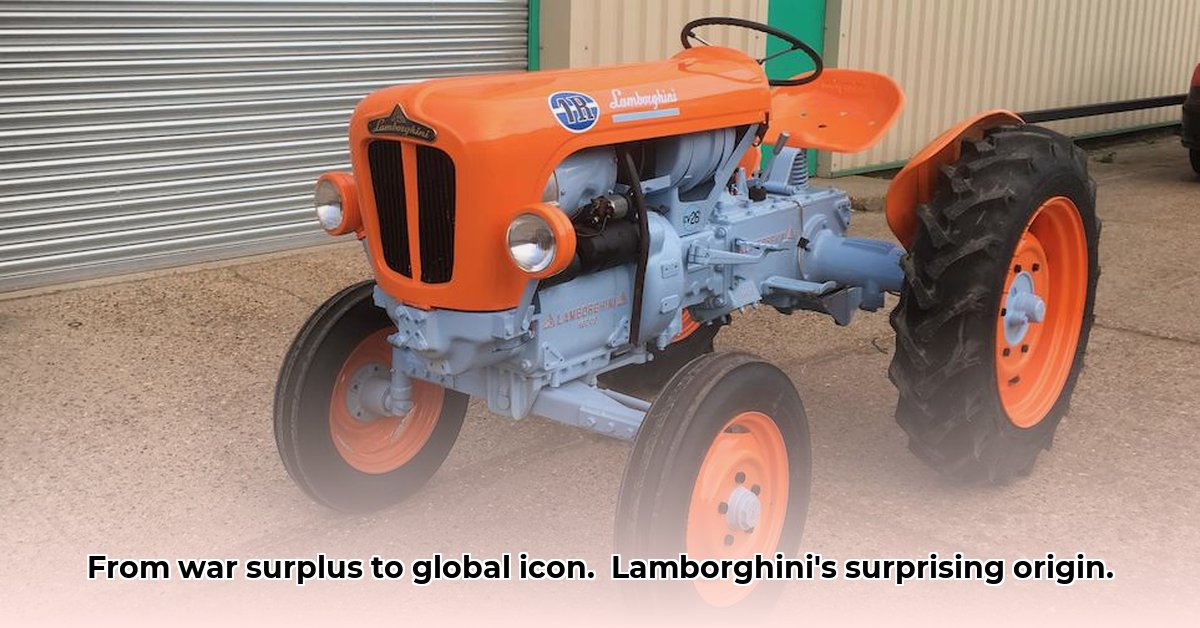
The year is 1948. Post-war Italy lay in ruins, yet from the ashes, Ferruccio Lamborghini emerged, transforming discarded war materials into a global agricultural powerhouse. This isn't just a business story; it's a testament to human ingenuity and unwavering determination. Learn more about Lamborghini's modern agricultural machinery at CNH Industrial.
Ingenious Beginnings: Forging a Giant from Scrap
Lamborghini's early tractors weren't born in gleaming factories; they were crafted from the remnants of war, a testament to resourcefulness and innovation. He masterfully repurposed materials from ARAR centers (centers that collected and reused war materials), turning what many considered junk into powerful, functional agricultural machines. This wasn't merely cost-effective; it was a sustainable approach to rebuilding a nation. His early designs were revolutionary, incorporating a groundbreaking fuel atomizer that allowed his tractors to run on both petrol and diesel, a critical advantage amidst post-war fuel shortages. How did this adaptability impact his early success? It provided farmers with reliable machinery regardless of available fuel sources, a crucial factor in ensuring operational efficiency.
From Humble Beginnings to Mass Production: Scaling for Success
Lamborghini's success wasn't solely reliant on clever design; it was fueled by efficient manufacturing. His production scaled dramatically, soaring from one tractor a week to an impressive 200 annually within a few short years. This remarkable growth wasn't accidental; it was the result of strategic planning, efficient processes, and a highly skilled workforce. This rapid expansion laid the foundation for his future dominance in the agricultural machinery market. Can you imagine the logistical challenges involved in such a rapid increase in production? It demanded a remarkable level of organizational skill and resource management.
Government Support and Market Dominance: A Perfect Storm
The Italian government played a pivotal role in Lamborghini's ascent. The Fanfani Law of 1952 offered significant financial incentives to farmers purchasing Italian-made equipment. This policy created a massive demand for Lamborghini's tractors, perfectly aligning with his burgeoning production capabilities. It was the ideal confluence of factors: a superior product meeting a substantial market need. The L33, introduced during this period, cemented Lamborghini's position as an industry leader. This model represented a significant step up in design and engineering refinement, further distinguishing it from earlier, more makeshift designs.
Technological Advancements: A Continuous Pursuit of Excellence
Lamborghini's commitment to innovation was unwavering. His tractors continually evolved, incorporating advanced features like synchronized gearboxes, significantly improving operational efficiency and ease of use. This relentless pursuit of technological excellence earned him numerous prestigious awards for models such as the Nitro, showcasing his dedication to quality. These awards weren't simply accolades; they represented concrete validation of Lamborghini's commitment to superior engineering and design. How did these technological improvements contribute to Lamborghini's market leadership? They ensured the ongoing competitiveness of his tractors in an increasingly dynamic market.
Beyond Tractors: A Diversified Legacy
Ferruccio Lamborghini's entrepreneurial spirit transcended the agricultural sector. His expansion into the automotive industry, with the establishment of Automobili Lamborghini, further demonstrates his remarkable business acumen and engineering prowess. This diversification showcased the transferability of his design skills and manufacturing expertise from agricultural machinery to the high-performance automotive market. What was the effect of this diversification on his legacy? It transformed his brand from a successful farming equipment manufacturer to a global symbol of design excellence.
The Lamborghini Legacy and its Future
The Lamborghini tractor of 1948 stands as a symbol of resilience, resourcefulness, and the transformative power of vision. Born from the ashes of war, it grew to become an agricultural giant, a testament to the remarkable ingenuity of its creator. While specific sustainability initiatives are not detailed here, the company’s enduring legacy demands reflection on its ongoing commitment to environmentally conscious practices, especially considering the evolving demands of modern agriculture. Lamborghini’s story is one of innovation, adaptation, and the pursuit of excellence; a powerful narrative that transcends the agricultural sector itself.